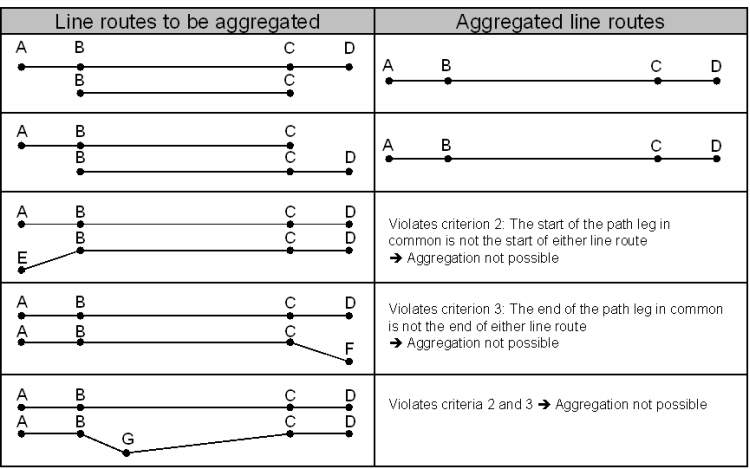Aggregation of line routes is the aggregation of several line routes or time profiles to combined objects. A number of line routes with the same or similar information can occur especially when importing old networks from Visum 8 or when importing timetable data from an external source. In an extreme case, both an individual line route and a specific time profile are created for each individual vehicle journey. Essential advantages of the hierarchical setup of the Visum PuT model are thus lost, such as the reuse of line route data for many vehicle journeys. Furthermore, the number of line routes makes editing and maintaining the overview more difficult. The function aggregate line routes supports you when importing third-party data, to use these to your advantage.
Criteria for aggregating line routes
When aggregating, two line routes are aggregated in the first step. Both line routes have to have common line path sections, but do not have to necessarily correspond with each other. If it has been determined, that two line routes can be aggregated successfully, the time profiles of a line route are tried to be aggregated in a second step. The following general criteria for the aggregation of line routes apply.
1. Both line routes have a common path leg.
2. The start of the common path leg is also the start of (at least) one of both line routes.
3. The end of the common path leg is also the end of (at least) one of both line routes.
The Illustration 23 shows examples of cases in which aggregation is possible and where not.

Illustration 23: Example of the aggregation of line routes
As an option, aggregating line routes can be made more difficult with the following conditions.
- Line routes have to be assigned to the same line.
- Line routes must have the same lengths on the common section.
- Line routes must have the same direction.
- Line routes must have the same start stop point
- Line routes must have the same end stop point
Aggregating time profiles can also be made more difficult as an option.
- Time profiles must have the same run and dwell times.
- Time profiles must have the same settings for boarding and alighting.
- Time profiles must have the same vehicle combination.
Relations between vehicle journeys
The following sections describe different types of relations between vehicle journeys. In principle, all concepts are similar. However, they do represent individual aspects of PuT supply and thus have an impact on different parts of the PuT model in Visum.
- Vehicle journey coupling
Vehicle journey coupling represents the concept of dividing trains which is widely used in rail transport. For example, on certain sections of the vehicle journey course, vehicle units are coupled together or separated from each other to adjust passenger capacity. In order to optimize both services and link capacity, multiple vehicle journeys (often using drive units in multiple traction) may be serviced jointly on central sections, which, however, serve separate link branches on the peripheral incoming and outgoing sections (Coupling of vehicle journeys)
- Passenger trip chains
Passenger trip chains model situations where, from the passenger's point of view, the change between two vehicle journeys does not mean that passengers have to change trains. An example is when in a tram network two lines are connected to form a ring-shaped course. Using passenger trip chains means that in the timetable-based assignment no transfer will be evaluated at the stop with the corresponding impedance values (Chained up vehicle journey sections)
- Forced chainings
Forced chainings are mainly used in line blocking when two successive vehicle journeys must be serviced by the same vehicle unit, meaning they need to be assigned to the same block.

